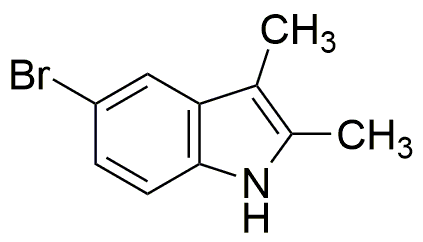5-Bromo-2,3-dimethylindole is widely utilized in research focused on:
- Pharmaceutical Development: This compound serves as a key intermediate in the synthesis of various pharmaceuticals, particularly in the development of anti-cancer agents. Its unique structure allows for modifications that enhance biological activity.
- Material Science: It is used in the formulation of organic light-emitting diodes (OLEDs), contributing to the production of efficient and vibrant display technologies. This application is crucial for the electronics industry, where high-quality displays are in demand.
- Biological Research: The compound is employed in studies related to enzyme inhibition and receptor binding, aiding researchers in understanding cellular processes and developing new therapeutic strategies.
- Organic Synthesis: It acts as a versatile building block in organic synthesis, allowing chemists to create complex molecules efficiently. This is particularly beneficial in academic and industrial laboratories focused on synthetic chemistry.
- Environmental Applications: Researchers are exploring its potential in developing sensors for detecting environmental pollutants, contributing to efforts in environmental monitoring and protection.
General Information
Properties
Safety and Regulations
Applications
5-Bromo-2,3-dimethylindole is widely utilized in research focused on:
- Pharmaceutical Development: This compound serves as a key intermediate in the synthesis of various pharmaceuticals, particularly in the development of anti-cancer agents. Its unique structure allows for modifications that enhance biological activity.
- Material Science: It is used in the formulation of organic light-emitting diodes (OLEDs), contributing to the production of efficient and vibrant display technologies. This application is crucial for the electronics industry, where high-quality displays are in demand.
- Biological Research: The compound is employed in studies related to enzyme inhibition and receptor binding, aiding researchers in understanding cellular processes and developing new therapeutic strategies.
- Organic Synthesis: It acts as a versatile building block in organic synthesis, allowing chemists to create complex molecules efficiently. This is particularly beneficial in academic and industrial laboratories focused on synthetic chemistry.
- Environmental Applications: Researchers are exploring its potential in developing sensors for detecting environmental pollutants, contributing to efforts in environmental monitoring and protection.
Documents
Safety Data Sheets (SDS)
The SDS provides comprehensive safety information on handling, storage, and disposal of the product.
Product Specification (PS)
The PS provides a comprehensive breakdown of the product’s properties, including chemical composition, physical state, purity, and storage requirements. It also details acceptable quality ranges and the product's intended applications.
Certificates of Analysis (COA)
Search for Certificates of Analysis (COA) by entering the products Lot Number. Lot and Batch Numbers can be found on a product’s label following the words ‘Lot’ or ‘Batch’.
*Catalog Number
*Lot Number
Certificates Of Origin (COO)
This COO confirms the country where the product was manufactured, and also details the materials and components used in it and whether it is derived from natural, synthetic, or other specific sources. This certificate may be required for customs, trade, and regulatory compliance.
*Catalog Number
*Lot Number
Safety Data Sheets (SDS)
The SDS provides comprehensive safety information on handling, storage, and disposal of the product.
DownloadProduct Specification (PS)
The PS provides a comprehensive breakdown of the product’s properties, including chemical composition, physical state, purity, and storage requirements. It also details acceptable quality ranges and the product's intended applications.
DownloadCertificates of Analysis (COA)
Search for Certificates of Analysis (COA) by entering the products Lot Number. Lot and Batch Numbers can be found on a product’s label following the words ‘Lot’ or ‘Batch’.
*Catalog Number
*Lot Number
Certificates Of Origin (COO)
This COO confirms the country where the product was manufactured, and also details the materials and components used in it and whether it is derived from natural, synthetic, or other specific sources. This certificate may be required for customs, trade, and regulatory compliance.


